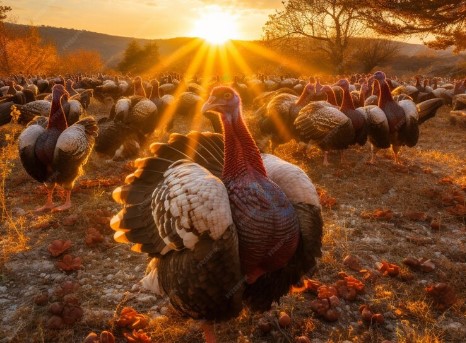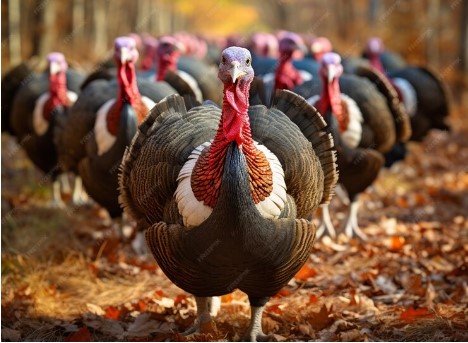Poultry farming accounts for 1.7% of the GDP, yet some areas, like turkey farming, haven’t been fully exploited. Turkey farming in Kenya is a lucrative agribusiness with high profit margins.
Turkey farming in Kenya requires minimal capital and excellent rearing skills such as breeding, husbandry, and health management. Mastering these essentials will help you establish a successful turkey farm, earning you massive profits.
Turkey farming is one of Kenya’s most profitable exotic poultry farming options. The bird produces high-quality meat and eggs, attracting high demand within and outside the country.
Depending on your budget, you can explore small-scale turkey farming and supply a small circle. Or large-scale turkey farming to sell your products to primary dealers and export them.
In this piece, we will cover:
- The benefits of turkey farming in Kenya
- Raising Turkey in Kenya
- The cost of turkey farming in Kenya
- Pro tips for successful turkey farming in Kenya

Let’s take an inside look!
Why Invest in Turkey Farming in Kenya?
With so many poultry farming options, you may wonder why you should focus on turkey farming. Here are some key reasons why
1. Requires Low Capital To Start
Did you know you could start turkey farming with Kshs 10,000 only?
Some of the most successful turkey farmers in Kenya began from this point. You should only ensure that you purchase the requirements like feed, housing, and health supplies.
Don’t hesitate to invest in turkey farming because of capital. You can start small and expand gradually!

2. Versatility
The use of turkey is diverse, including produce(eggs and meat) and exhibition. This exotic bird serves multiple purposes that you can utilize to run a profitable business.
Again, turkey business is not restricted by the state’s boundaries. With a large-scale turkey farm, you can produce a lot of meat and eggs, exporting overseas at top dollar.
Why not venture into turkey farming?
3. Market Availability
One of the most challenging factors in most agribusiness ventures in Kenya is finding a market for your produce. Moreover, most agribusiness products are highly perishable, leaving farmers with massive losses.
You don’t have to face the same fate thanks to the high demand for turkey products. You can enjoy a ready market for your products when you start turkey farming in Kenya.
Raising Turkey in Kenya

The knowledge and skills to raise turkey is essential to run a successful turkey farm. Here are some of the critical aspects of turkey-rearing
Breeds and Breeding Turkeys
What breeds of turkey are available in Kenya?
What turkey breeds do well in Kenya?
Although turkeys are not classified into breeds, they’re distinguished using the following varieties.
- White Holland
- Black
- Slate
- Bronze
- Bourbon Red
- Narragansett
- Beltsville Small White
The most popular turkeys in Kenya include White Holland and Bronze. In most turkey farms in Kenya, you will find

- The Broad Breasted White Holland
This bird is black, with female ones bearing white feather tips at 12 weeks old. The broad-breasted white is fast-growing and boasts a weight of 7kg to 11kg when they hit 24 weeks.
- The Broad-Breasted White
This turkey is a product of the Broad-Breasted Bronze and the White Holland crossbreed. The broad-breasted white can withstand hot weather conditions and boasts a clean appearance.
Rearing Systems for Turkey Farming in Kenya
You can apply the following rearing systems depending on your budget, farm size, and produce goals.
1. Free Range System
The free-range system refers to a large farm where turkeys are allowed to roam freely to feed and drink water. An acre of land can hold up to 200 mature birds.
2. Deep Litter System
This is a modern method of rearing turkeys that utilizes enclosed housing. Usually, the farmer places food and water in these structures. A good example is a 5ft by 8ft structure housing a maximum of 20 birds.
Feeding Turkeys

Like other poultry farming requirements, proper feeding in turkey farming is essential to maximize your produce and profit margins.
So, how do you feed turkeys?
Turkey’s feeding requirements are almost like those of chicken. Their feed should be protein-rich for fast growth and healthy weight gain.
When starting your farm, you should feed the day-old birds with mash and lots of water. Then, after 2½ months, feed them growers’ mash accompanied by minerals, vitamins, and calcium supplements.
Note that turkeys in the free-range system consume less food than those in the deep litter system.
Health Management
Turkeys are susceptible to pests and diseases and, therefore, require optimum care to ensure you prevent illnesses. So, how do you counter this to avoid losses?
You can utilize biosecurity, which refers to applying measures that slow down or stop the entry or spread of infections on your turkey farm. Some of the critical practices in this method include
- Managing people
- Monitoring equipment
- Controlling pests
- Proper mortality disposal
These practices will help you minimize or eradicate the possibility of common turkey diseases such as Newcastle disease, Fowlpox, Histomoniasis, Fowl cholera, Erysipelas, and Haemorrhagic enteritis.
Roundworms and Foul mites are the most common turkey parasites. Usually, they cause extreme discomfort and mortality, reducing your farm’s production and causing losses. You can eradicate these parasites by deworming your birds once per month.
Best Husbandry Practices
What are the best husbandry practices for a lucrative turkey farming business in Kenya?
To maximize your produce and returns, you should observe the following practices.
1. Debeaking
Also known as beak trimming, debeaking removes beaks to stop turkeys from picking their feathers. It’s usually done at the age of 3 weeks or ten days.
2. Desnooding
This is the removal of the snood (tubular fleshly appendage at the front top of a turkey’s head). This is usually practiced when the bird is one day or 3 weeks old.
Desnooding prevents injuries caused during fights or picking. The process is much easier when the bird is smaller, so you should aim to eradicate the snood at a day old.
3. Toe Clipping
You’re perhaps in a dilemma as to why toe-clipping is essential for poultry farming. Turkeys grow strong and sharp nails, and when excited in large groups of birds, they step on each other.
This causes skin tears and scratches on the sides and backs. Farmers clip the birds’ nails at 5 weeks of age using a nail clipper, surgical scissors, or a debeaker to avoid this.
4. Wing Clipping
Wing clipping is done at 15 weeks to prevent birds from flying.
The Cost of Turkey Farming In Kenya
As a new turkey farmer, Kshs 10,000 to Kshs 15,000 is enough to start your agribusiness. Here is a cost breakdown
- Structure – Kshs 5,000
- Feeding and drinking items – Kshs 1,500
- Feeds (20 kilograms) – Kshs 1100
- 6 to 8 turkey birds – Kshs 6,000
- Miscellaneous – Kshs 1,700
Total Cost – Kshs 15,000
How Profitable Is Turkey Farming In Kenya?
Turkey farming in Kenya is exceptionally profitable compared to most poultry agribusinesses. Moreover, with proper knowledge and skills to rear these birds, you can expect four times the revenue of a chicken farm.
Tips for Successful Turkey Farming In Kenya

Starting and running a turkey farm can be daunting, especially if you’re a first-time farmer. Fortunately, you don’t have to go through trial and error.
Here are some pro tips that successful farmers apply to realize their business goals
1. Research Thoroughly
You’re about to enter a new business requiring unique skills and knowledge to thrive. As a result, a shallow understanding of the market, farming requirements, and business management can lead to inefficiency and unproductivity, reducing your produce.
Fortunately, with proper research, you’ll understand all the requirements and get exposure from other successful turkey farmers. You’ll also understand how the market works, for instance, the stability in turkey demand and the peaks versus the lows.
All this information will make starting and running a successful business easy.
2. Choose The Best Breed
Turkeys come in different varieties. However, some have more delicious meat than others. For instance, Kenya’s Broad Chested White turkey has high-quality meat, attracting high demand.
Again, the maturity and fertility of turkeys vary, with small chests exhibiting excellent brooding and productivity than the rest of the breeds. So, choose the best-performing varieties, but don’t limit yourself to a specific poult.
3. Get Enough Feed Supply
A turkey can consume over 40 kgs of feed between the first day and six months of age. You should feed your birds with chick mash, maize flour, vegetables, and ground omena for optimum productivity.
4. Observe Vaccination Requirements
Turkeys are vulnerable to poultry illnesses and pest attacks. Hence, you should observe the appropriate vaccination recommendations from veterinarians.
This will help you eliminate or minimize disease or pest-related losses.
5. Implement Book Keeping Practices
Keeping records is crucial in any successful business. It helps you monitor the cash going out of all your expenditures, including feed, vaccination and treatment, and labor.
You can also compare this amount with the returns to ensure you’re earning profits. Again, with these records, you can make the necessary adjustments to minimize costs and maximize profits.
Also Read:
Frequently Asked Questions
1. How Much Is Mature Turkey In Kenya?
The price for turkeys is as follows
- Kshs 400 for a day-old poult
- Kshs 500 for a week-old bird
- Kshs 900 for a month-old turkey
- Kshs 3,500 for a mature female bird
2. How Long Does It Take To Farm A Turkey?
A hen matures at 14 weeks with a weight of 15.5 pounds, while a tom matures at 18 weeks with 38 pounds.
3. What Is The Price Of A Turkey In Kenya?
Depending on the size and weight, a turkey can cost from Kshs 1,600 to Kshs 3,500.
Conclusion
Turkey farming in Kenya is a lucrative agribusiness that realizes four times the returns of chicken farming. However, you have to implement the best practices to enjoy maximum returns.
You can apply the pro tips and attend training from successful farmers for the best results. Then, learn how the market operates for seamless business operation.
To learn more about money-making business opportunities, ideas, saving, and viable investment opportunities, check out our store for exhaustive guides.







